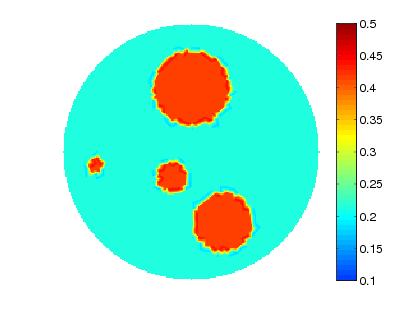Inverse Problem of Cancer Detection (IPCD) Through Electrical Impedance Tomography (EIT)

Electrical Impedance Tomography (EIT) is a rapidly developing non-invasive medical imaging technique with various applications for cancer detection and screening purposes. Different parts of the human body react differently to the electrical current which appears due to the voltages applied by placing electrodes. A very well known fact is that the electrical properties (e.g. electrical conductivity or permittivity) of different tissues are changing if the status of a tissue is changing from healthy to cancer-affected. Thus this allows to develop simple techniques aiming to produce images of the biological tissues by interpreting their response to applied voltages (or injected currents) of single or multiple frequencies. This imaging approach has became very popular due to the following reasons:
- Small alternating currents (ACs) of high frequency are easily injected into the body via surface electrodes and could provide almost no harm to the tissue in terms of triggering electrolytic effects or nerve stimulation.
- EIT does not apply any kind of harmful ionizing radiation, instead, for recording the tissue response, it uses the change in the properties of the electrical signals which are collected by the same electrodes.
- Technologically EIT is easier and cheaper in implementation in comparison with the conventional computed tomography (CT) and magnetic resonance imaging (MRI) technologies.


As one of the examples of applicability, EIT is widely used in the field of breast imaging as an alternative or complimentary technique to x-rays mammography and MRI for breast cancer detection. Detecting and localizing the areas of tissue pathology usually rely on multi-frequency EIT (MF-EIT, aka Electrical Impedance Spectroscopy, EIS) which is based on comparisons of EIT images obtained at varying AC frequencies.
In practice, patients carry the burden of high level of distress and health care costs associated with a relatively high rate of false positive screenings due to low specificity of mammography and MRI methods. In addition to this higher risks are added by applying ionizing radiation in the former and by administering the contrast agent in the latter. This inspires for further development of alternative imaging techniques, such as EIT imaging, which can be seen in extending the bounds for applicability, simplicity and reliability.
Project Collaborators
- Ugur G. Abdulla (Florida Institute of Technology)
- Saleheh Seif (Florida Institute of Technology)
References
- U.G. Abdulla, V. Bukshtynov, S. Seif, "Cancer Detection through Electrical Impedance Tomography and Optimal Control Theory: Theoretical and Computational Analysis", Mathematical Biosciences & Engineering 18(4), 4834-4859, 2021 (the final version of the paper is available at doi: 10.3934/mbe.2021246; see also arXiv:1809.05936).
